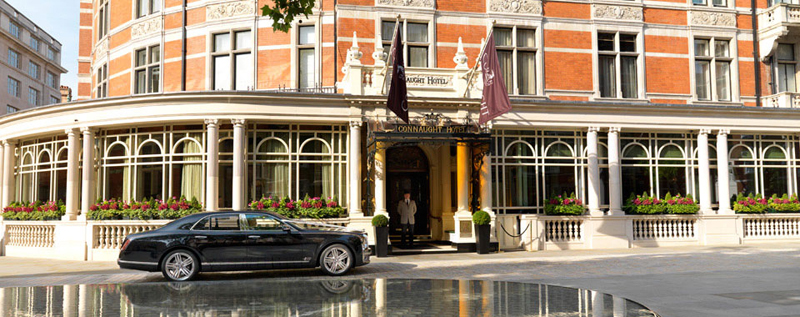
The Grande Dame of Mayfair hotels, The Connaught has seen changes of ownership and reinvention since opening in 1815 as the Prince Saxe Coburg Hotel. The adoption of the less Germanic “Connaught” in 1917 was one of these. Acquired in 1956 by the Savoy Group – now known as the Maybourne Hotel Group – it underwent a £70 million programme of restoration, refurbishment and redecoration in 2007 under lead designer Guy Oliver. Further investment in 2008 included the opening of the Connaught Bar, designed by David Collins, a new Espelette Restaurant with a covered terrace, and the Coburg Bar
Modernisation has also been reflected in changes in cooking style, from the staunchly classical French cuisine of Michel Bourdin to the more contemporary interpretations of Angela Hartnett and, since 2008, Hélène Darroze.
Yet, despite these changes, the traditional values of fine dining, refinement and generous hospitality have been preserved. These are epitomised in the lavishly decorated oak-panelled dining room designed by India Mahdavi, where the latest gastronomic creations are underpinned by luxurious furnishings, and professional yet engaging service.

In her eponymous restaurant, Hélène Darroze continues to dazzle with her exciting contemporary French cuisine. This is only to be expected from a chef with two Michelin stars who was also named the Veuve Clicquot World’s Best Female Chef (2015) and thrice decorated with France’s celebrated Order of Chevalier. Creativity, meticulous attention to detail and a pairing of classical skills with cutting edge techniques applied to impeccably sourced ingredients have produced show stopping dishes to satisfy the most discerning of palates.
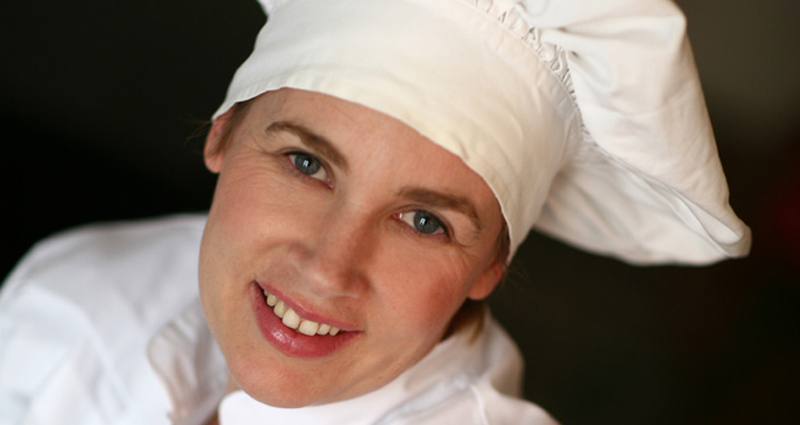
An innovative French approach to Sunday lunch, in what is a venerable British institution, may indeed defy defenders of traditional British dining, roast beef and all. Yet this is not the first time that Hélène Darroze has successfully challenged this sacred cow – no pun intended. In 2016, “Le Poulet du Dimanche” proved an unqualified success, so much so that March 2017 saw the launch of “Le Pot-au-feu du Dimanche.” The challenge was to transform a humble, one pot peasant dish into a sophisticated multi-course offering (through deconstruction) whilst retaining the essence of the original meat and vegetable stew.
The meal began with a trio of delicate canapes. A crisp cone encased succulent, well seasoned beef tartare topped with a Greek yogurt mousse. Smoked eel with crème fraiche on a puff cracker – a magical combination – simply dissolved in the mouth. A mushroom veloute was smooth and deeply flavoured.

Roasted bone marrow, presented au naturel, proved a wonderful mixture of textures and temperatures. The melting richness of the warm bone marrow was balanced by its parsley crust and enlivened with capers, pickled shallots and Meyer lemon. Gem lettuce and a salad of fine herbs added freshness and fragrance, although the addition of caviar was superfluous to the success of the dish.
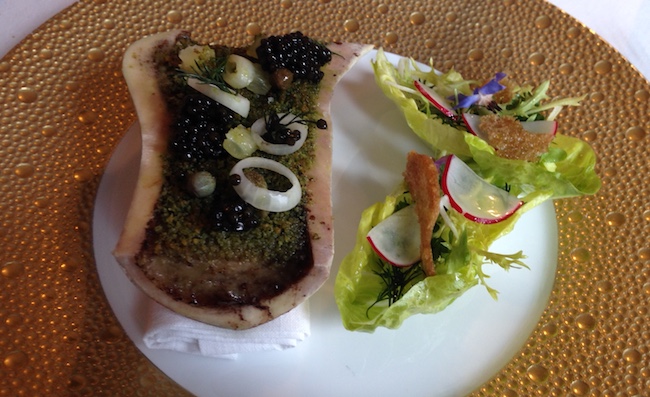
Next came leeks cooked in three contrasting ways: charred leeks, soft and gently smoky, stuffed with “saucisson Lyonnaise”; crisp deep fried leek shards; and a creamy leek veloute. Perigord black truffle added a heady earthy fragrance, elevating the dish to lofty heights. The marriage of the humble with the luxurious, given an element of theatre with the shaving of the truffle at the table, proved a harmonious combination.

The main course showcased beautifully sourced meat and offal, all requiring different cooking times. Lake District beef fillet was scored highly for flavour and texture. Foie gras from Les Landes, poached in a cabbage leaf, retained the creamy richness and muted livery flavour unique to this delectable piece of offal. Unctuous confit pork belly was meltingly soft, and veal sausage well-seasoned. Root vegetables, green beans and cabbage added flavour, crunch and colour, whilst a light, clear broth delicately perfumed with ginger and lemon grass gave an unexpected yet agreeable Thai influence which lifted the other elements.
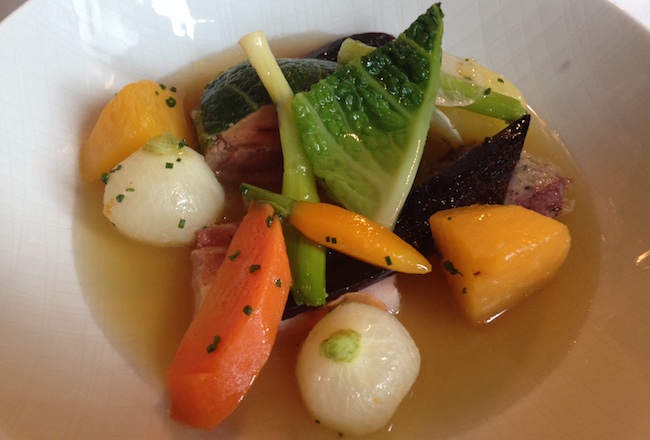
Presented on a silver tray before being deftly plated at the table, this attractive dish took Pot-au-feu to a whole new level of sophistication whilst retaining the generosity of spirit inherent in the original.
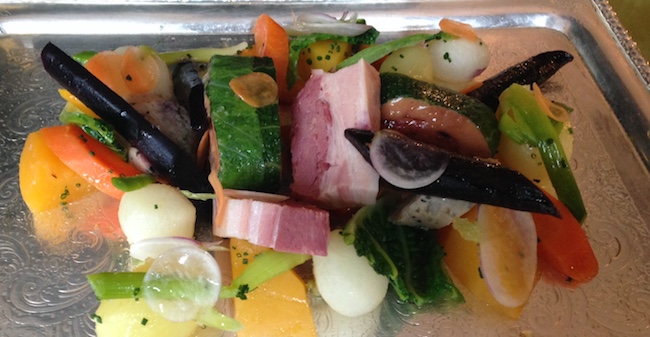
The meatfest continued with a refreshingly light gelee of beef consommé with a confit terrine of brisket, beef cheek and oxtail. Here the cheaper cuts requiring long, slow cooking were employed with telling effect, the dish being packed with bovine deliciousness. Balanced by gently cooked young vegetables and salad which gave freshness and a quenelle of horseradish and grain mustard for added zing, this was another well composed dish.
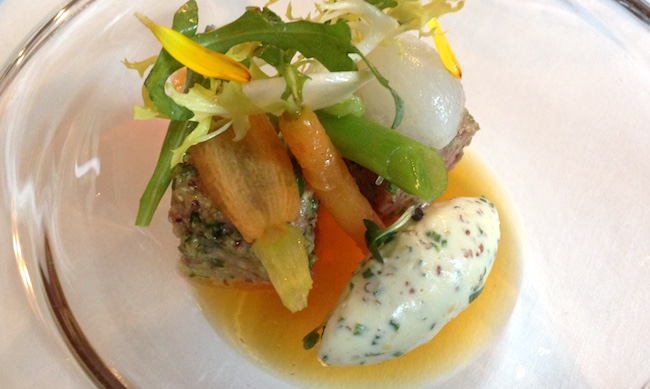
Deconstructed lemon tart has become somewhat of a cliché, but this could hardly be said of Helene Darroze’s version. Firstly the use of Meyer lemon, the aristocrat of that species, in confit, candied and sorbet forms gave the citric qualities of the dessert greater intensity. Delicate round tuiles of Breton sable contrasted with the coriander and lime emulsion and soft meringue that decorated the plate. This proved as suitably light and refreshing dessert after the demands of the preceding courses.
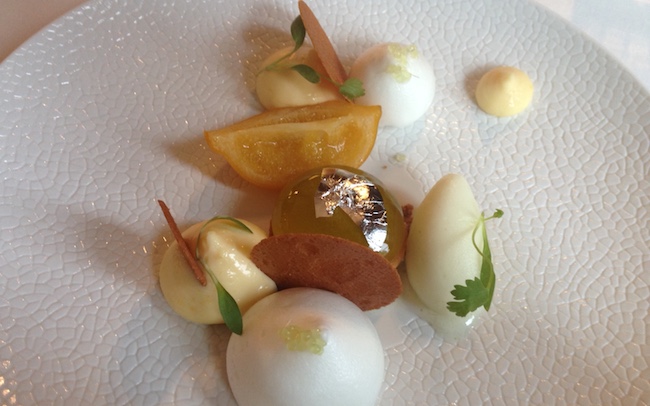
Good coffee and petit fours completed this memorable meal, enhanced by the seamless service overseen by acting restaurant manager Damian. Welcoming, courteous and knowledgeable, it was totally professional without being stiff or condescending. Clearly the front of house did full justice to the fertile imagination and sharply honed skills of the chef and her team.



